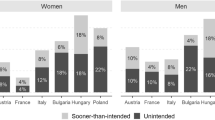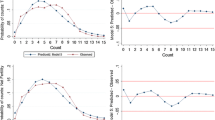Abstract
We examine the potential effects of selection bias on the association between unwanted births and child mortality from 7,942 women from Matlab, Bangladesh who declared birth intentions in 1990 prior to conceiving pregnancies. We explore and test two opposing reasons for bias in the distribution of observed births. First, some women who report not wanting more children could face starvation or frailty; and if these women are infecund, the remaining unwanted births would appear more healthy. Second, some women who report not wanting more children could have social privileges in acquiring medical services, abortion, and contraceptives; and if these women avoid births, the remaining unwanted births would appear less healthy. We find (1) no overall effect of unwantedness on child survival in rural Bangladesh in the 1990s, (2) no evidence that biological processes are spuriously making the birth cohort look more healthy, and (3) some evidence that higher schooling for women who avoid unwanted births is biasing the observed sample to make unwanted births look less healthy. Efforts to understand the effect of unwantedness in data sets that do not control for complex patterns of selective birth may be misleading and require more cautious interpretation.


Similar content being viewed by others
References
Bankole, A., & Westoff, C. (1998). The consistency and validity of reproductive attitudes: Evidence from Morocco. Journal of Biosocial Science, 30, 439–455.
Baydar, N. (1995). Consequences for children of their birth planning status. Family Planning Perspectives, 27, 228–234, 245.
Brown, S., & Eisenberg, L. (Eds.). (1995). The best intentions: Unintended pregnancy and the well-being of children and families. Washington, DC: National Academies Press.
Casterline, J., El-Zanaty, F., & El-Zeini, L. (2003). Unmet need and unintended fertility: Longitudinal evidence from Upper Egypt. International Family Planning Perspectives, 29, 158–166.
Chalasani, S., Casterline, J. B., & Koenig, M. A. (2007, March). Consequences of unwanted childbearing: A study of child outcomes in Bangladesh. Paper presented at the annual meeting of the Population Association of America, New York, NY.
DaVanzo, J., Hale, L., Razzaque, A., & Rahman, M. (2008). The effects of pregnancy spacing on infant and child mortality in Matlab, Bangladesh: How they vary by the type of pregnancy outcome that began the interval. Population Studies, 62, 131–154.
DaVanzo, J., Rahman, M., Ahmed, S., & Razzaque, A. (2013). Influences on pregnancy-termination decisions in Matlab, Bangladesh. Demography, 50, 1739–1764.
Diamond-Smith, N., & Potts, M. (2011). A woman cannot die from a pregnancy she does not have. International Perspectives on Sexual and Reproductive Health, 37, 155–158.
Dixon-Mueller, R. (1988). Innovations in reproductive health care: Menstrual regulation policies and programs in Bangladesh. Studies in Family Planning, 19, 129–140.
Eggleston, E., Tsui, A. O., & Kotelchuck, M. (2001). Unintended pregnancy and low birthweight in Ecuador. American Journal of Public Health, 91, 808–810.
Fawcus, S. R., Crowther, C. A., Van Baelen, P., & Marumahoko, J. (1992). Booked and unbooked mothers delivering at Harare Maternity Hospital, Zimbabwe: A comparison of maternal characteristics and foetal outcome. Central African Journal of Medicine, 38, 402–408.
Finer, L. B., & Henshaw, S. K. (2006). Disparities in rates of unintended pregnancy in the United States, 1994 and 2001. Perspectives on Sexual and Reproductive Health, 38, 90–96.
Forrest, J. D. (1994). Epidemiology of unintended pregnancy and contraceptive use. American Journal of Obstetrics and Gynecology, 170, 1485–1489.
Forssman, H., & Thuwe, I. (1981). Continued follow-up study of 120 persons born after refusal of application for therapeutic abortion. Acta Psychiatrica Scandinavica, 64, 142–149.
Gage, A. (1998). Premarital childbearing, unwanted fertility and maternity care in Kenya and Namibia. Population Studies, 52, 21–34.
Gazmararian, J. A., Adams, M. M., Saltzman, L. E., Johnson, C. H., Bruce, F. C., Marks, J. S., & Zahniser, S. C. (1995). The relationship between pregnancy intendedness and physical violence in mothers of newborns. The PRAMS Working Group. Obstetrics and Gynecology, 85, 1031–1038.
Gipson, J. D., Koenig, M. A., & Hindin, M. J. (2008). The effects of unintended pregnancy on infant, child, and parental health: A review of the literature. Studies in Family Planning, 39, 18–38.
Joyce, T., Kaestner, R., & Korenman, S. (2002). On the validity of retrospective assessments of pregnancy intention. Demography, 39, 199–213.
Koenig, M. A., Acharya, R., Singh, S., & Roy, T. K. (2006). Do current measurement approaches underestimate levels of unwanted childbearing? Evidence from rural India. Population Studies, 60, 243–256.
Korenman, S., Kaestner, R., & Joyce, T. (2002). Consequences for infants of parental disagreement in pregnancy intention. Perspectives on Sexual and Reproductive Health, 34, 198–205.
Kubicka, L., Matejcek, Z., David, H. P., Dytrych, Z., Miller, W. B., & Roth, Z. (1995). Children from unwanted pregnancies in Prague, Czech Republic revisited at age thirty. Acta Psychiatrica Scandanavica, 91, 361–369.
Lordan, G., & Frijters, P. (2013). Unplanned pregnancy and the impact on sibling health outcomes. Health Economics, 22, 903–914.
Magadi, M. A., Madise, N. J., & Rodrigues, R. N. (2000). Frequency and timing of antenatal care in Kenya: Explaining the variations between women of different communities. Social Science & Medicine, 51, 551–561.
Manski, C. (1989). Anatomy of the selection problem. Journal of Human Resources, 24, 343–360.
Marsiglio, W., & Mott, F. (1988). Does wanting to become pregnant with a first child affect subsequent maternal behaviors and birth weight. Journal of Marriage and Family, 50, 1023–1036.
Marston, C., & Cleland, J. (2003). Do unintended pregnancies carried to term lead to adverse outcomes for mother and child? An assessment in five developing countries. Population Studies, 57, 77–93.
Matejcek, Z., Dytrych, Z., & Schuller, V. (1978). Children from unwanted pregnancies. Acta Psychiatrica Scandinavica, 57, 67–90.
Montgomery, M. R., Lloyd, C. B., Hewett, P. C., & Heuveline, P. (1997). The consequences of imperfect fertility control for children’s survival, health, and schooling (Demographic and Health Surveys Analytical Reports No. 7). Calverton, MD: Macro International.
Myhrman, A., Olsen, P., Rantakallio, P., & Laara, E. (1995). Does the wantedness of a pregnancy predict a child’s educational attainment? Family Planning Perspectives, 27, 116–119.
Pop‐Eleches, C. (2006). The impact of an abortion ban on socioeconomic outcomes of children: Evidence from Romania. Journal of Political Economy, 114, 744–773.
Pulley, L., Klerman, L. V., Tang, H., & Baker, B. A. (2002). The extent of pregnancy mistiming and its association with maternal characteristics and behaviors and pregnancy outcomes. Perspectives in Sexual Reproductive Health, 34, 206–211.
Razzaque, A., Streatfield, P. K., & Gwatkin, D. R. (2007). Does health intervention improve socioeconomic inequalities of neonatal, infant and child mortality? Evidence from Matlab, Bangladesh. International Journal for Equity in Health, 6, 4. doi:10.1186/1475-9276-6-4
Rosenzweig, M., & Wolpin, K. (1993). Maternal expectations and ex post rationalization. Journal of Human Resources, 28, 205–227.
Singh, S., Sedgh, G., & Hussain, R. (2010). Unintended pregnancy: Worldwide levels, trends, and outcomes. Studies in Family Planning, 41, 241–250.
Yeatman, S., Sennott, C., & Culpepper, S. (2013). Young women’s dynamic family size preferences in the context of transitioning fertility. Demography, 50, 1715–1737.
Acknowledgments
Supported by NICHD 1 R03 HD069730-01. Helpful comments from John Casterline, Jessica Gipson, and Paul Stupp are gratefully acknowledged.
Author information
Authors and Affiliations
Corresponding author
Rights and permissions
About this article
Cite this article
Bishai, D., Razzaque, A., Christiansen, S. et al. Selection Bias in the Link Between Child Wantedness and Child Survival: Theory and Data From Matlab, Bangladesh. Demography 52, 61–82 (2015). https://doi.org/10.1007/s13524-014-0354-1
Published:
Issue Date:
DOI: https://doi.org/10.1007/s13524-014-0354-1




